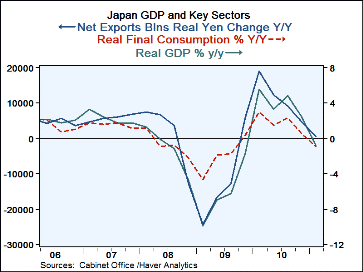 Global| May 19 2011
Global| May 19 2011Japan GDP Falls Hard
Summary
The chart tells a pretty clear story for Japan. Although the quake and tsunami were late in the quarter they exerted a strong negative impact on Japan’s 2011 Q1 GDP. Because of this timing Q2 is sure to reflect further substantial [...]
 The chart tells a pretty clear story for Japan. Although the quake and tsunami were late in the quarter they exerted a strong negative
impact on Japan’s 2011 Q1 GDP. Because of this timing Q2 is sure to reflect further substantial impact from these negative developments.
The chart tells a pretty clear story for Japan. Although the quake and tsunami were late in the quarter they exerted a strong negative
impact on Japan’s 2011 Q1 GDP. Because of this timing Q2 is sure to reflect further substantial impact from these negative developments.
Japan’s GDP fell at a 3.7% pace in Q1. Private consumption was off at a sharp 2.2% pace. Meanwhile, plant and equipment investment contracted by a very sharp 3.5%.with gross capital formation off at a 3% pace. But one of the big factors impacting GDP was the surge in imports against a tepid rise in exports. . The deterioration in net exports cuts nearly one-half of one percentage point off the GDP (annualized) growth rate in the quarter in Japan. We have seen troubles linger and the crisis over radioactivity drag on. Japan has been managing its problems with an electricity shortage a bit better than originally expected, still these factors will continued to hold back growth in Q2 and beyond.
Japan’s housing investment was positive in Q1 rising at a 2.9% paces (SAAR) quarter-over-quarter. But domestic demand fell by 3% and fell for the second quarter in a row, having dropped at a 2.7% pace in Q4 of 2010.
While it is being said that Japan has slipped back into recession, today’s report did not rock markets. And while it is probably is true that Japan is back in recession it is also in a particularly artificial one with a lot of resources dedicated to help dig it out. The plunge in GDP was created by a disaster, not by economic excess gone amok. Japan’s economic statistics are going to continue to look a bleaker in the next quarter than Japan’s prospects really are. The Japanese are a determined people and they will pull themselves out of this catastrophe with greater ease than they extricated themselves from their lingering period of deflation.
| Japan's GDP | ||||||||||
|---|---|---|---|---|---|---|---|---|---|---|
| Consumption | Capital Formation | Trade | ||||||||
| GDP | Pvt. | Public | Gross Fix Cap |
Plnt& Equip |
Housing | X-M: bns E |
Export | Import | Domestic Demand |
|
| % Change Q/Q at Annual Rates of Change; X-M is Q/Q Change in Blns of Real Yen | ||||||||||
| Q1-11 | -3.7% | -2.2% | 3.9% | -3.0% | -3.5% | 2.9% | -0.6 | 2.8% | 8.2% | -3.0% |
| Q4-10 | -3.0% | -3.9% | 1.5% | -2.8% | 0.5% | 13.3% | -0.5 | -3.3% | -1.3% | -2.7% |
| Q3-10 | 3.8% | 3.3% | 1.3% | 1.8% | 4.4% | 8.0% | -0.3 | 6.6% | 12.2% | 4.6% |
| Q2-10 | 0.2% | -0.6% | 5.0% | 2.9% | 11.2% | -2.2% | 1.9 | 22.4% | 17.3% | -0.6% |
| % Change Yr/Yr; X-M is Yr/Yr Change in Gap in Blns of Real Yen | ||||||||||
| Q1-11 | -0.7% | -0.9% | 2.9% | -0.3% | 3.0% | 5.3% | 0.5 | 6.7% | 8.9% | -0.5% |
| Q4-10 | 2.4% | 0.6% | 1.5% | 1.4% | 5.4% | 6.1% | 4.6 | 13.1% | 9.8% | 2.0% |
| Q3-10 | 4.8% | 2.3% | 2.1% | 2.9% | 6.6% | -1.1% | 9.0 | 21.1% | 11.3% | 3.5% |
| Q2-10 | 3.3% | 1.5% | 2.9% | -0.5% | 3.0% | -10.5% | 12.3 | 29.8% | 14.2% | 1.5% |
| 5-Yrs | -0.3% | 0.0% | 2.1% | -3.3% | -2.0% | -7.1% | N/A | 1.7% | -0.1% | -0.6% |
Robert Brusca
AuthorMore in Author Profile »Robert A. Brusca is Chief Economist of Fact and Opinion Economics, a consulting firm he founded in Manhattan. He has been an economist on Wall Street for over 25 years. He has visited central banking and large institutional clients in over 30 countries in his career as an economist. Mr. Brusca was a Divisional Research Chief at the Federal Reserve Bank of NY (Chief of the International Financial markets Division), a Fed Watcher at Irving Trust and Chief Economist at Nikko Securities International. He is widely quoted and appears in various media. Mr. Brusca holds an MA and Ph.D. in economics from Michigan State University and a BA in Economics from the University of Michigan. His research pursues his strong interests in non aligned policy economics as well as international economics. FAO Economics’ research targets investors to assist them in making better investment decisions in stocks, bonds and in a variety of international assets. The company does not manage money and has no conflicts in giving economic advice.






